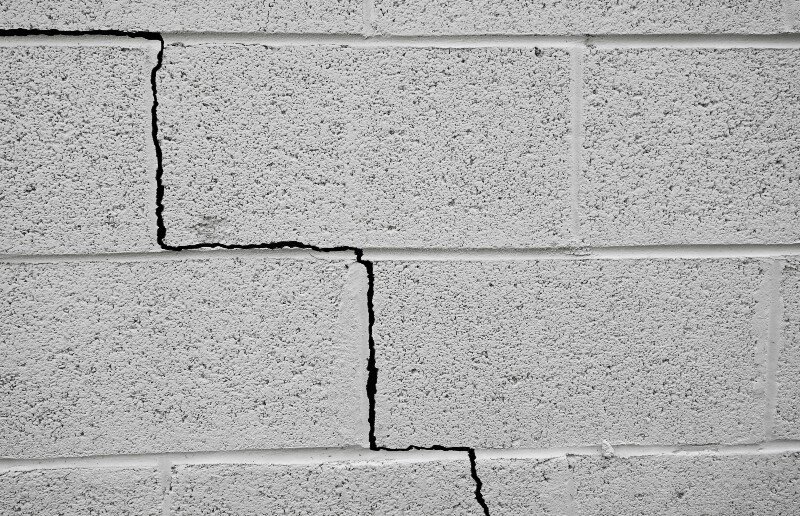
No homeowner wants to see cracks in their foundation. Foundation cracks will affect the value of your home. Fortunately, some cracks are not as severe as others. Foundation cracks occur in all shapes and sizes. Homeowners must know the difference between a minor crack and a foundation crack that could be a severe problem.
What Are Vertical Foundation Cracks on a Property?
Foundation settlement can cause several types of foundation cracks.
Vertical Foundation cracks are those that run up and down your foundation walls. These cracks are the least problematic, and you can repair these cracks quickly and easily.
Vertical cracks are typically smaller than ⅛ inch in width. Concrete shrinkage can cause these cracks in your basement walls, and you usually notice them towards the middle of the walls. You should cover cracks until you can repair them to prevent bugs and water leaks.
If you notice larger vertical cracks in different areas, it may be an indication that you need to contact a professional. You should get a foundation contractor to determine the cause of the damages.
Horizontal foundation cracks are more severe and are often caused by hydrostatic water pressure against your foundation wall. You will often find horizontal cracks in a block foundation, and a frost heave will contribute to unbalanced pressure against your foundation walls.
Stair step cracks are common in block foundations. You will find these cracks along the mortar joints, which are generally caused by foundation settlement or shrinkage. These types of cracks can pose a severe threat to the structural integrity of your house. A call to your local foundation contractor is in order.
Hairline cracks are common in new construction, and you will notice these small cracks within a year as your new home’s foundation settles and dries. Repairing hairline cracks is an easy diy project for most homeowners, and you can cover most hairline cracks with a coat of paint.
Diagonal cracks do not cause structural problems, and they occur with the natural settling of the foundation. Owners can repair a diagonal wall crack with epoxy injection.
Shrinkage cracks occur as your foundation settles and loses moisture. New constructions are prone to shrinkage cracks within the first year. Check your warranty because it may cover the crack repair.
A non-structural foundation crack is relatively common and does not threaten the house’s structure. Homeowners may find that rainwater and melted snow leak into the basement through these cracks.
Structural foundation cracks are the most serious. These are horizontal cracks and cracks that are wider than 1/4 inch. Movement of the house causes these cracks, and changes in temperature, soil pressure, and shrinkage can contribute to this movement.
These cracks will take more than an epoxy injection, and you need to install carbon fiber countersunk staples or straps for support.
Some cracks are more problematic than others. If you have any doubts, your best bet is to ask for a free inspection by a foundation expert, and they will provide you with a free quote detailing the foundation repair cost. Sometimes, the wisest route is to have a professional foundation contractor repair the damage, and most companies will warranty their repairs.
How To Identify Vertical Foundation Cracks
Vertical foundation cracks are standard, but it is essential to identify their cause and repair them.
You may see vertical cracks in masonry between two structures. This damage often happens due to differential settlement or thermal movement. Homeowners may see this when they add an extension to their home, which can be dangerous if not properly addressed.
There are also very straight vertical lines or wandering lines in poured concrete. These occur as the concrete shrinks and do not threaten your concrete foundation’s structural integrity.
Vertical foundation cracks that are straight and found near the end of the walls can be dangerous, and these cracks can lead to an eventual collapse.
You might also see vertical foundation cracks that are wider at the bottom. Foundation settlement due to a frost heave will cause these. These cracks are not serious unless you find them in a brick wall.
Can You Fix Foundation Cracks
Your foundation surrounds your basement and crawlspace, which is essential for supporting the weight of your house. When you see foundation damage, you must address it immediately. Homeowners will be happy to learn that they can quickly fix most foundation problems.
You can have a structural engineer inspect your foundation to ensure there is no threat to the structural integrity of your home. They can identify the type of cracks and the cause of the damage, and they may have suggestions to prevent further cracks.
Homeowners can fix hairline cracks with a coat of masonry paint. You should monitor larger cracks for several months to see if they get any bigger. If there is no change, you can fill it with grout using a putty knife.
You can fix a crack that is more significant than 1/8 of an inch by filling it with a caulk that works with concrete. Apply the caulk and smooth it over, making a smooth finish. You may have to apply it several times until the wall is smooth.
You may notice water leaking through the cracks, so waterproofing becomes your priority. You should install gutters and downspouts to keep moisture from your foundation walls. Apply a sealant to the cracks.
When you notice any more than 1/2 inch wide crack, you should have a professional inspect the problem. You may be able to fix the crack yourself, but you should be sure that you can recognize the signs of a bad foundation.
How To Fix Vertical Foundation Cracks
Vertical and more minor hairline foundation cracks are the easiest to repair. They do not necessarily need to be repaired, but if you plan to sell your home, it is best to have a foundation free of cracks.
There are some instances in which you should immediately repair the crack. When you see rainwater seeping through the crack in your basement, you should immediately make repairs. Standing water in your basement can contribute to mold and mildew.
You should definitely make repairs if you see any bricks or cement blocks that have moved. Cracks that extend through the brick or block should be addressed quickly.
Homeowners should inspect their foundations regularly. If you notice that cracks are growing, investigate further, as this could be a sign of a more severe problem.
If you notice a foundation wall bowing inward, you should contact a foundation contractor immediately. Bowing can be a sign that your foundation is headed for collapse.
You can hire a professional foundation contractor to repair the cracks, but it is an easy fix. Ensure that the crack is completely dry, inject urethane caulk, or use an epoxy concrete repair kit.

How To Sell a House With Vertical Foundation Cracks
Homeowners considering selling and knowing they have some issues with their basement foundation should contact a structural engineer for an inspection. Foundation problems will limit the number of buyers for your home, and lenders often refuse a mortgage for a home with foundation issues. Both selling a damaged house and selling a condemned house can be challenging, and an engineer’s report will be crucial to the successful sale of your home.
The engineer can identify problems and recommend the best way to repair them. They may find vertical cracks, which are not a serious problem. Even though homeowners can quickly fix vertical cracks, having a professional do the repairs is better. Most foundation companies will offer a warranty for their repairs which is transferrable to the new owner.
The engineer’s report, along with the receipt for the repair, can ease the mind of a potential buyer and their lender.
Some buyers will be hesitant to buy when they know about foundation cracks. Homeowners may have to negotiate their price to convince the buyer that the damages are not a problem. Savvy buyers will know they can use the foundation issues to lower the asking price.
Some buyers, such as house flippers or real estate investors, look for houses with foundation problems that they can quickly fix. You can sell a house fast in Hartford and not worry about repairing the foundation.
If your foundation has only a few minor vertical cracks, you should repair them before putting your house on the market or contacting we buy houses in Oshkosh.
If there are a significant number of vertical cracks or other types of more severe cracks, you need to decide whether it is worth it to fix them or not. You could sell your house to a company like cash home buyers in Wisconsin and not worry about the cost of repairs.
Conclusion paragraph
Every home will have foundation cracks at one time or another. Homeowners must learn to recognize the types of cracks and their seriousness. Your foundation is one of the essential parts of your house; it supports your home and ensures that you are safely sheltered. You should ensure that the structural integrity of your foundation is maintained.
